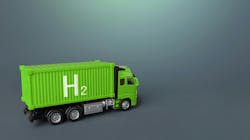GM, Celedyne Expanding Work on Hydrogen Fuel Cells for Heavy Duty Transportation
Hydrogen technology firm Celadyne is expanding its work with automaker General Motors (GM) on heavy duty mobility systems utilizing fuel cells.
The collaboration will use Celayne’s Dura technology to develop fuel cells for heavy-duty transportation applications including trucking and industrial use, according to reports. The GM-Celadyne partnership is one of 16 projects which the U.S. Department of Energy awarded a total $47 million in funding for develop hydrogen in enhancing power electronics design, motor integration and optimization for electric drive systems.
Fuel cell technologies convert fuels into electricity through an electrochemical reaction. Celadyne’s Dura uses advanced cells with thin membranes and allows protons to move quickly and efficiently, according to reports.
The layers control the movement of gasses and ions without slowing down proton movement. Fuel cells will not work for heavy-duty trucking or redox flow batteries without these qualities, Celadyne says.
GM, one of the world’s largest automakers to actively develop decarbonization strategies, also is working with Honda to begin commercial production of hydrogen fuel cell systems at a plant in Michigan.
In recent weeks, GM signed a 15-year solar energy power purchase agreement with NorthStar Clean Energy to supply renewable electricity equivalent to the demand from three assembly plants in Michigan and Missouri. The GM Defense subsidiary also is developing and providing battery electric technology intended for future military platforms.
Fuel cell systems do not emit carbon dioxide and only produce water in exhaust. Hydrogen does not contain carbon in its chain, but is generated only through steam reforming of natural gas or by electrolysis splitting the H2 molecule from water.
About the Author
Rod Walton, EnergyTech Managing Editor
Managing Editor
For EnergyTech editorial inquiries, please contact Managing Editor Rod Walton at [email protected].
Rod Walton has spent 17 years covering the energy industry as a newspaper and trade journalist. He formerly was energy writer and business editor at the Tulsa World. Later, he spent six years covering the electricity power sector for Pennwell and Clarion Events. He joined Endeavor and EnergyTech in November 2021.
Walton earned his Bachelors degree in journalism from the University of Oklahoma. His career stops include the Moore American, Bartlesville Examiner-Enterprise, Wagoner Tribune and Tulsa World.
EnergyTech is focused on the mission critical and large-scale energy users and their sustainability and resiliency goals. These include the commercial and industrial sectors, as well as the military, universities, data centers and microgrids. The C&I sectors together account for close to 30 percent of greenhouse gas emissions in the U.S.
He was named Managing Editor for Microgrid Knowledge and EnergyTech starting July 1, 2023
Many large-scale energy users such as Fortune 500 companies, and mission-critical users such as military bases, universities, healthcare facilities, public safety and data centers, shifting their energy priorities to reach net-zero carbon goals within the coming decades. These include plans for renewable energy power purchase agreements, but also on-site resiliency projects such as microgrids, combined heat and power, rooftop solar, energy storage, digitalization and building efficiency upgrades.

